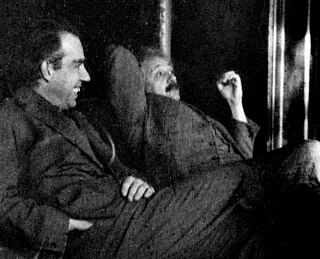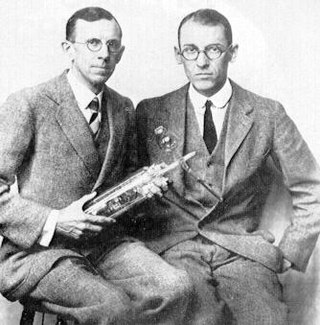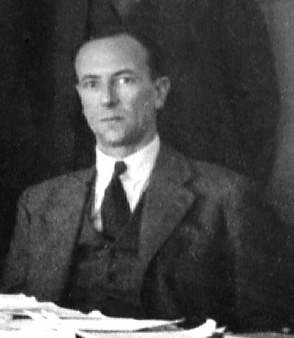
Niels Henrik David Bohr was a Danish physicist who made foundational contributions to understanding atomic structure and quantum theory, for which he received the Nobel Prize in Physics in 1922. Bohr was also a philosopher and a promoter of scientific research.
A photon is an elementary particle that is a quantum of the electromagnetic field, including electromagnetic radiation such as light and radio waves, and the force carrier for the electromagnetic force. Photons are massless particles that always move at the speed of light measured in vacuum. The photon belongs to the class of boson particles.
Wave-particle duality is the concept in quantum mechanics that quantum entities exhibit particle or wave properties according to the experimental circumstances. It expresses the inability of the classical concepts such as particle or wave to fully describe the behavior of quantum objects. During the 19th and early 20th centuries, light was found to behave as a wave then later discovered to have a particulate behavior, whereas electrons behaved like particles in early experiments then later discovered to have wavelike behavior. The concept of duality arose to name these seeming contradictions.

Compton scattering is the quantum theory of high frequency photons scattering following an interaction with a charged particle, usually an electron. Specifically, when the photon hits electrons, it releases loosely bound electrons from the outer valence shells of atoms or molecules.
A timeline of atomic and subatomic physics.
In physics, a correspondence principle is any one of several premises or assertions about the relationship between classical and quantum mechanics. The physicist Niels Bohr coined the term in 1920 during the early development of quantum theory; he used it to explain how quantized classical orbitals connect to quantum radiation. Modern sources often use the term for the idea that the behavior of systems described by quantum theory reproduces classical physics in the limit of large quantum numbers: for large orbits and for large energies, quantum calculations must agree with classical calculations. A "generalized" correspondence principle refers to the requirement for a broad set of connections between any old and new theory.

Johannes Wilhelm "Hans" Geiger was a German physicist. He is best known as the co-inventor of the detector component of the Geiger counter and for the Geiger–Marsden experiment which discovered the atomic nucleus. He also carried the Bothe–Geiger coincidence experiment that confirmed the conservation of energy in light-particle interactions.
In physics and electrical engineering, a coincidence circuit or coincidence gate is an electronic device with one output and two inputs. The output activates only when the circuit receives signals within a time window accepted as at the same time and in parallel at both inputs. Coincidence circuits are widely used in particle detectors and in other areas of science and technology.

Walther Wilhelm Georg Bothe was a German nuclear physicist known for the development of coincidence methods to study particle physics.

The Bohr–Einstein debates were a series of public disputes about quantum mechanics between Albert Einstein and Niels Bohr. Their debates are remembered because of their importance to the philosophy of science, insofar as the disagreements—and the outcome of Bohr's version of quantum mechanics becoming the prevalent view—form the root of the modern understanding of physics. Most of Bohr's version of the events held in the Solvay Conference in 1927 and other places was first written by Bohr decades later in an article titled, "Discussions with Einstein on Epistemological Problems in Atomic Physics". Based on the article, the philosophical issue of the debate was whether Bohr's Copenhagen interpretation of quantum mechanics, which centered on his belief of complementarity, was valid in explaining nature. Despite their differences of opinion and the succeeding discoveries that helped solidify quantum mechanics, Bohr and Einstein maintained a mutual admiration that was to last the rest of their lives.
In physics, complementarity is a conceptual aspect of quantum mechanics that Niels Bohr regarded as an essential feature of the theory. The complementarity principle holds that certain pairs of complementary properties cannot all be observed or measured simultaneously. For example, position and momentum or wave and particle properties. In contemporary terms, complementarity encompasses both the uncertainty principle and wave-particle duality.

The Davisson–Germer experiment was a 1923-27 experiment by Clinton Davisson and Lester Germer at Western Electric, in which electrons, scattered by the surface of a crystal of nickel metal, displayed a diffraction pattern. This confirmed the hypothesis, advanced by Louis de Broglie in 1924, of wave-particle duality, and also the wave mechanics approach of the Schrödinger equation. It was an experimental milestone in the creation of quantum mechanics.
Quantum mechanics is the study of matter and its interactions with energy on the scale of atomic and subatomic particles. By contrast, classical physics explains matter and energy only on a scale familiar to human experience, including the behavior of astronomical bodies such as the moon. Classical physics is still used in much of modern science and technology. However, towards the end of the 19th century, scientists discovered phenomena in both the large (macro) and the small (micro) worlds that classical physics could not explain. The desire to resolve inconsistencies between observed phenomena and classical theory led to a revolution in physics, a shift in the original scientific paradigm: the development of quantum mechanics.
Heisenberg's microscope is a thought experiment proposed by Werner Heisenberg that has served as the nucleus of some commonly held ideas about quantum mechanics. In particular, it provides an argument for the uncertainty principle on the basis of the principles of classical optics.
The history of quantum mechanics is a fundamental part of the history of modern physics. The major chapters of this history begin with the emergence of quantum ideas to explain individual phenomena—blackbody radiation, the photoelectric effect, solar emission spectra—an era called the Old or Older quantum theories. Building on the technology developed in classical mechanics, the invention of wave mechanics by Erwin Schrödinger and expansion by many others triggers the "modern" era beginning around 1925. Paul Dirac's relativistic quantum theory work lead him to explore quantum theories of radiation, culminating in quantum electrodynamics, the first quantum field theory. The history of quantum mechanics continues in the history of quantum field theory. The history of quantum chemistry, theoretical basis of chemical structure, reactivity, and bonding, interlaces with the events discussed in this article.
In the history of quantum mechanics, the Bohr–Kramers–Slater (BKS) theory was perhaps the final attempt at understanding the interaction of matter and electromagnetic radiation on the basis of the so-called old quantum theory, in which quantum phenomena are treated by imposing quantum restrictions on classically describable behaviour. It was advanced in 1924, and sticks to a classical wave description of the electromagnetic field. It was perhaps more a research program than a full physical theory, the ideas that are developed not being worked out in a quantitative way. The purpose of BKS theory was to disprove Einstein's hypothesis of the light quantum.
The timeline of quantum mechanics is a list of key events in the history of quantum mechanics, quantum field theories and quantum chemistry.
In 1923, American physicist William Duane presented a discrete momentum-exchange model of the reflection of X-ray photons by a crystal lattice. Duane showed that such a model gives the same scattering angles as the ones calculated via a wave diffraction model, see Bragg's Law.

The discovery of the neutron and its properties was central to the extraordinary developments in atomic physics in the first half of the 20th century. Early in the century, Ernest Rutherford developed a crude model of the atom, based on the gold foil experiment of Hans Geiger and Ernest Marsden. In this model, atoms had their mass and positive electric charge concentrated in a very small nucleus. By 1920, isotopes of chemical elements had been discovered, the atomic masses had been determined to be (approximately) integer multiples of the mass of the hydrogen atom, and the atomic number had been identified as the charge on the nucleus. Throughout the 1920s, the nucleus was viewed as composed of combinations of protons and electrons, the two elementary particles known at the time, but that model presented several experimental and theoretical contradictions.
A hallmark of Albert Einstein's career was his use of visualized thought experiments as a fundamental tool for understanding physical issues and for elucidating his concepts to others. Einstein's thought experiments took diverse forms. In his youth, he mentally chased beams of light. For special relativity, he employed moving trains and flashes of lightning to explain his most penetrating insights. For general relativity, he considered a person falling off a roof, accelerating elevators, blind beetles crawling on curved surfaces and the like. In his debates with Niels Bohr on the nature of reality, he proposed imaginary devices that attempted to show, at least in concept, how the Heisenberg uncertainty principle might be evaded. In a profound contribution to the literature on quantum mechanics, Einstein considered two particles briefly interacting and then flying apart so that their states are correlated, anticipating the phenomenon known as quantum entanglement.







